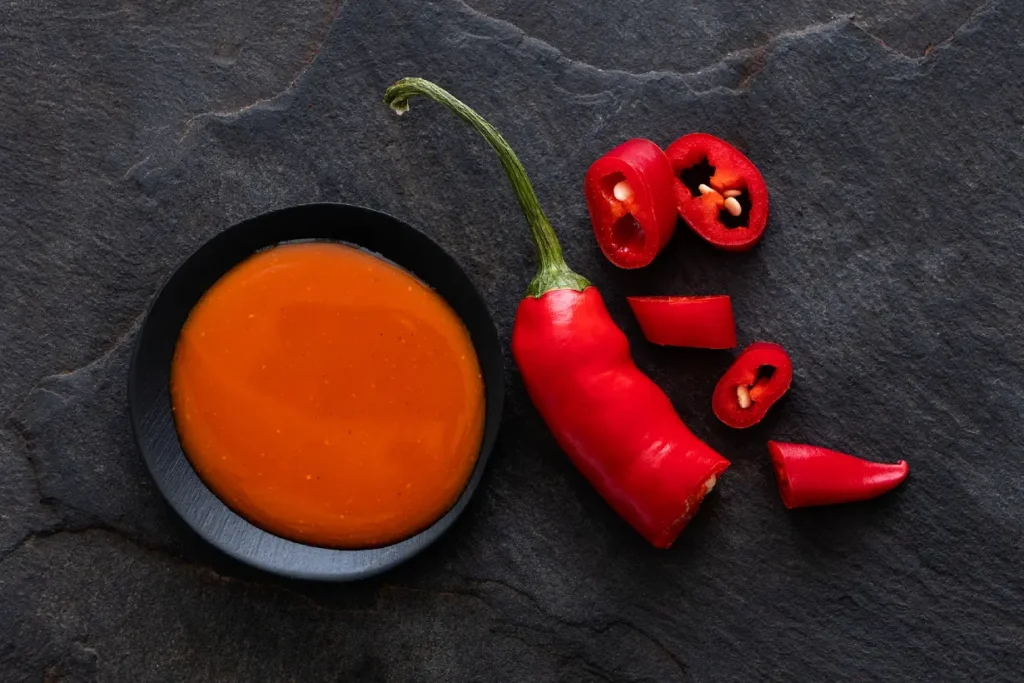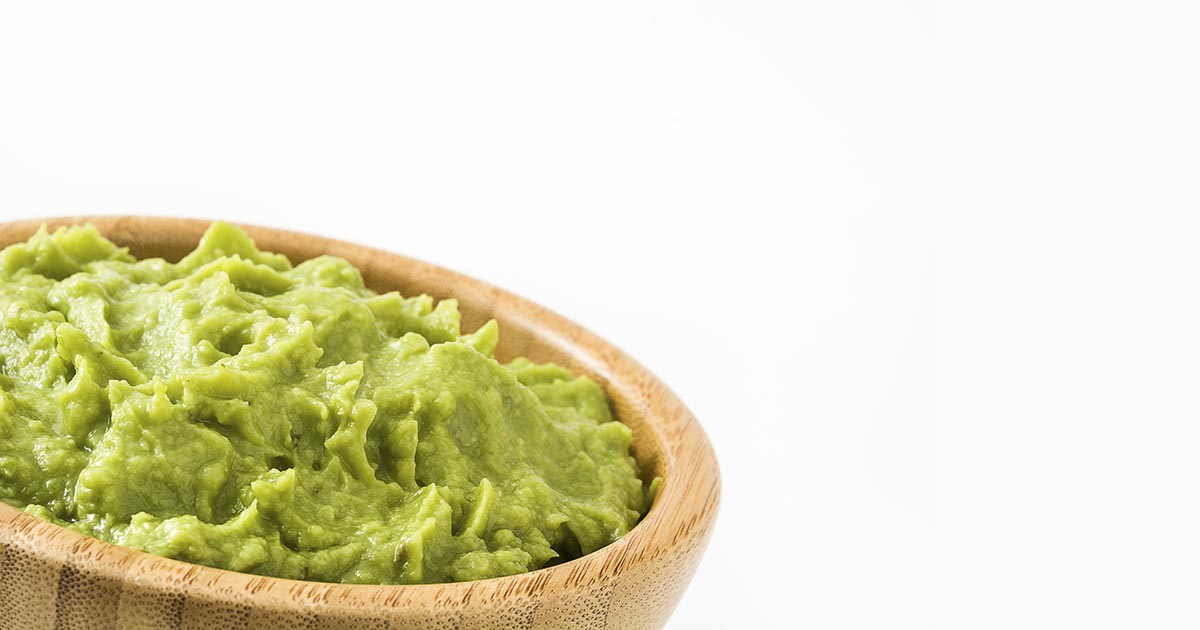Hot sauce is a popular condiment that has almost become a global staple for the burst of flavor it adds to food.
While hot sauce can enhance the taste of dishes, what’s actually in it? And what does it provide nutritionally?
This article gives you all the information you need about hot sauce, from its ingredients profile and nutritional values to its potential benefits and drawbacks.
Let’s see what it has to offer.
Important Note: The content in this article is for informational and educational purposes only. It should not replace medical advice from your healthcare provider.
Table of contents
The Nutritional Value of Hot Sauce

Let’s start by examining the nutritional profiles of the most popular hot sauce varieties.
Below is a table showing basic the calorie, sugar, and sodium content per teaspoon for these sauces. Nutritional data is sourced either from the manufacturer or the USDA FoodData Central database (1, 2, 3, 4, 5, 6):
| Hot Sauce | Calories | Sugar | Sodium |
|---|---|---|---|
| Frank’s Redhot | 0 kcal | 0 g | 190 mg |
| Louisiana | 0 kcal | 0 g | 200 mg |
| Peri Peri | 5 kcal | 0 g | 90 mg |
| Sriracha | 6 kcal | 1 g | 138 mg |
| Tabasco | 0 kcal | 0 g | 35 mg |
Ingredients
Let’s now take a look at the key ingredients in these common hot sauce options.
Frank’s Redhot
Frank’s Redhot contains the following ingredients (1):
- Aged cayenne red peppers
- Distilled vinegar
- Water
- Salt
- Garlic powder
The sauce uses cayenne peppers as its primary ingredient and has a heat level of 450 Scoville Heat Units (SHU) (7).
Frank’s Redhot sauce is high in sodium but contains no added sugar.
Louisiana Hot Sauce
Louisiana hot sauce has the following ingredients (3):
- Aged peppers
- Distilled vinegar
- Salt
Louisiana hot sauce also has a heat level of 450 SHU and is high in sodium (8).
Peri Peri Sauce
Peri peri sauce contains these ingredients (4):
- Water
- Vinegar
- African bird’s eye chilli
- Cayenne pepper
- Paprika
- Lemon puree
- Salt
- Onion puree
- Sunflower oil
- Garlic puree
Peri peri’s heat level varies by brand and ingredient concentrations, with various options like “mild” and “hot” being available.
It has slightly less sodium than Frank’s Redhot and Louisiana and contains no added sugar.
Sriracha
Sriracha hot sauce contains (5):
- Chili
- Sugar
- Salt
- Garlic
- Distilled vinegar
Sriracha contains a small amount of added sugar and has a heat level of 2,200 SHU (9).
Tabasco
Original Tabasco hot sauce has the following ingredients (6):
- Distilled vinegar
- Red pepper
- Salt
Its heat level is rated at 2,500 SHU (10).
Does Hot Sauce Provide Essential Vitamins and Minerals?
Chilli peppers are the primary ingredient in hot sauce, and chilli peppers are a rich source of various vitamins and minerals.
However, hot sauce is consumed in small teaspoon-sized servings. It also has contains water, vinegar, or both. For these reasons, a serving of hot sauce is not a significant source of vitamins or minerals.
Based on USDA data for Sriracha, here are the most concentrated vitamins and minerals you’ll find in a teaspoon of hot sauce (5):
| Nutrient | Amount (1 tsp) | % Daily Value |
|---|---|---|
| Sodium | 138 mg | 6% |
| Vitamin C | 1.75 mg | 2% |
| Vitamin E | 0.31 mg | 2% |
| Vitamin B6 | 0.03 mg | 2% |
| Riboflavin (B2) | 0.01 mg | 1% |
As the table shows, hot sauce isn’t a meaningful source of vitamins or minerals. However, its sodium content is quite high for such a small serving size.
The Potential Benefits of Hot Sauce
Despite its lack of vitamins and minerals, hot sauce may offer several benefits.
May Have a Slight Thermogenic Effect
A thermogenic effect occurs when a food increases metabolic rate, requiring more energy to digest. Hot sauce might have a small thermogenic effect due to its capsaicin content, because systematic reviews of randomized controlled trials have shown that capsaicin can increase resting metabolic rate by approximately 33–50 calories per day (11, 12).
However, these modest results from clinical trials were based on doses of capsaicin starting at around 2 mg per day and going up to over 10 mg. In contrast, a teaspoon serving of hot sauce provides less than 1 mg of capsaicin—one study found that tabasco contained 12 mg of capsaicin per 100g, which is approximately 0.6 mg of capsaicin per teaspoon (13, 14).
Therefore, while hot sauce may slightly increase calories burned, it’s unlikely to be significant. You’d also need at least 3-4 servings to hit the 2 mg/day minimal dose of capsaicin where benefits were observed.
Can Improve the Taste of Food
One simple key benefit: hot sauce can increase enjoyment of food.
While this may not seem like a health benefit, it can encourage eating more healthy foods. For example, condiments like hot sauce can make lean proteins and vegetables more enjoyable.
When we enjoy food, we’re more likely to eat it often.
Some other popular ingredients used for seasoning purposes in this way include sesame oil and pesto.
Hot Sauce Is a Low-Calorie Condiment
Another benefit is that hot sauce contains virtually zero calories. As previously mentioned, major hot sauce varieties contain at most 5-6 calories per teaspoon.
This is a big contrast to some condiments—for example, mayonnaise has nearly 100 calories per tablespoon (15).
For individuals aiming to lose weight or limit added calories, hot sauce is an excellent choice.
May Potentially Improve Blood Lipids and Blood Glucose Levels
Observational studies and randomized controlled trials indicates that high doses of capsaicin may improve blood glucose levels (16, 17).
However, these effects were observed at doses around 5 mg per day. To get this much capsaicin from hot sauce, you’d need about nine teaspoos—which would be a substantial amount of sodium.
A systematic review of randomized controlled trials also found that capsaicin supplementation slightly lowered LDL cholesterol (LDL-C) by an average 0.23 mmol/L (8.9 mg/dL) compared to the control group (18). LDL-C is sometimes referred to as “bad” cholesterol because elevated levels are a causal risk factor for cardiovascular disease (18, 19).
Again, capsaicin doses were high in these trials and ranged from around 3-9 mg per day.
While hot sauce could potentially benefit blood glucose and cholesterol if consumed in large amounts, the required intake may adversely affect blood pressure due to sodium.
Drawbacks of Hot Sauce
Some potential drawbacks of hot sauce include its high sodium content and its unsuitability for people with sensitive palates.
Very High in Sodium
According to USDA data, a teaspoon of sriracha hot sauce contains 138 mg of sodium, which is 6% of the daily value (5).
The Dietary Guidelines for Americans 2020–2025 recommend consuming no more than 2,300 mg of sodium per day (20).
However, as we looked at earlier, some hot sauce varieties can contain more than 138 mg of sodium—Frank’s Redhot has 200 mg per teaspoon (1).
Additionally, dishes marinated in a large amount of hot sauce can contain significantly more than one teaspoon. Therefore, when using hot sauce it is important to be mindful of the amount and stick to the recommended serving size.
Too Spicy For Some People
People who use hot sauce generally want to add a bit of spice to their food.
That said, it can limit who enjoys the dish. For instance, not everyone likes spicy food, and hot sauce may not suit children or anyone with milder tastes.
As a source of capsaicin, hot sauce can also trigger heartburn for people with acid reflux (20).
These are things worth keeping in mind if cooking for a group of people.
How To Incorporate Hot Sauce
Hot sauce is a simple and versatile ingredient. Here are some ways to use it:
- As a marinade: Mix a little hot sauce with sesame oil and soy sauce, then marinate meat, fish, tofu, or vegetables before roasting.
- Scrambled egg: Add a teaspoon of hot sauce to scrambled eggs for a different, spicier taste.
- Soups and stews: Stir in a serving of hot sauce to your favorite soup or stew.
- Spicy dip: Create a hot sauce dip by mixing a teaspoon of hot sauce with Greek yogurt or sour cream. Season with chives and onion powder, and then use it as a dip.
- Stir-fry: Add a teaspoon or two of hot sauce to your favorite stir-fry for a bit of heat.
- Spicy carbonara: Mix hot sauce with Greek yogurt, an egg, and some Parmesan cheese and black pepper for a spicier carbonara-style pasta sauce
- Spicy mayonnaise: Mix in a drizzle of hot sauce to mayonnaise for a spicier variety.
- Table condiment: Drizzle a little hot sauce on top of your favorite foods.
Is Hot Sauce a Healthy Choice?
Hot sauce offer vitamins and minerals in small amounts, making it an insignificant dietary source of key nutrients.
Typical serving sizes of hot sauce are also unlikely to provide the effective doses of capsaicin used in clinical trials. Since hot sauce is high in sodium, we should also take care to consume it in moderation to keep sodium intake within recommended levels.
That said, many people enjoy spicy food, and hot sauce can enhance the flavor of otherwise bland dishes. When paired alongside nutrient-rich, healthy foods, hot sauce can contribute to a healthy dish.
At the end of the day, hot sauce can fit into a healthy diet when used in moderation. Individual preferences and health conditions—such as acid reflux—will also influence whether hot sauce is a good choice.
Frequently Asked Questions
Have questions about hot sauce? Here are quick answers to some of the most common queries.
A teaspoon of hot sauce typically contains between 0 and 5 calories. It is a low-calorie condiment.
There is less than 1 mg of capsaicin per teaspoon of hot sauce. One study found that a 5-gram teaspoon of Tabasco hot sauce contains around 0.6 mg of capsaicin (13).
Depending on the variety and brand, the sodium content of hot sauce can range from 35 to 200 mg per teaspoon.
Several studies support capsaicin—the compound responsible for the heat in chilli peppers—having health benefits. However, the capsaicin doses seen in these studies are significantly higher than the amount in a typical hot sauce serving.
The high sodium content of hot sauce is its biggest potential downside, particularly if it is habitually consumed in large amounts.
Tabasco has significantly lower sodium levels than other popular hot sauce varieties.








